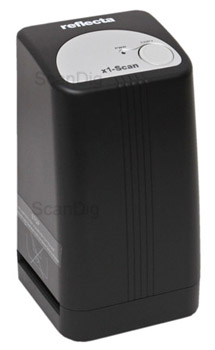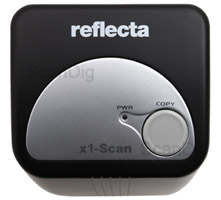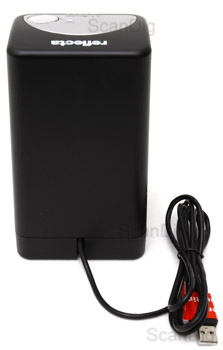 |
Reflecta x1-Scan - Film scanner with CMOS-sensor
With the reflecta x-Scan, the first film scanner was introduced into the market in autumn 2007 that did not scan the slides and the negatives line by line with a CCD line sensor but captured the whole original film material at once with a CMOS-chip, thus quasi pictured it as a digital camera. The Reflecta xScan only stayed in the market up to September 2008 and was then replaced by the Reflecta X2-Scan.
The Reflecta x1-Scan was replaced by its successor Reflecta x2-Scan in September 2008. While in spring 2009 still a Reflecta X3-Scan was introduced into the market as the first film scanner that can be operated without using a PC, in autumn 2009, the Reflecta x1-Scan came into the market quasi as a laggard. By looking at the case of the Reflecta x1-Scan, one will immediately recognize the similarity with the reflecta x-Scan. Nothing has changed except the label. Thus, is the Reflecta x1-Scan only a x-Scan with another product description? The x1-Scan has the same film holder as the x-Scan, thus a slide frame adapter for up to 3 framed slides of 35-mm and a film strip adapter for negative film strips of a length up to 6 images. The x1-Scan either digitalizes positives as also negatives, that means also some framed negatived can be inserted into the slide adapter, and in the film strip adapter also positive strips and single images (positives and negatives) can be inserted.

Even though the film adapters suggest the buyers that, due to the possibility of inserting several pieces of film material at once, the film material is automatically and consecutively scanned, some manual work is required. As it is the case of the Reflecta x-Scan, one has to load the slide adapter or the negative adapter with some 35-mm slides or 35-mm negatives, inserts then the adapter into the scanner, makes a preview of the image, sets some adjustments, scans the image and then moves the film adapter manually up to the next image position, so that the next image can be digitalized.
The Reflecta x1Scan digitalizes the 35-mm films with a resolution of 1800 dpi; the scans with such a resolution are of an image size of approximately 5 megapixels, thus of a lower camera level. As we showed in our detailed test report about the reflecta x-Scan, the real resolution that such a scanner provides in practice is lower than announced on the data sheet. In the case of the Reflecta x-Scan, we have measured a resolution of 1500 dpi; in the case of the x1-Scan, the measured value should be within a similar margin. But a resolution of 1500 dpi means that one will only get approximately 3 megapixels of real image information, thus the remaining 2 megapixels are redundant. Therewith, the scanner takes only very few image information from the 35-mm film. Considering that the 35-mm slides or the 35-mm negatives that were exposed with a good camera contain some image information up to 20 megapixels, one rapidly recognizes that with the Reflecta x1-Scan it is only possibe to get a fraction of the actual image information contained in the film.

Thus, concerning the resolution, there were no changes between the x1-Scan and the x-Scan. Also the maximum density of 3,0 announced by the producer remained the same. The resulting range of density of approximately 2,5 means that in the bright and dark image areas, the device cannot distinguish any details anymore, which means that very dark areas become simply black and the very bright areas simply white. Top-film scanners have a range of density that is from 10 up to 100 times bigger than the one of the x-Scan. Due to the lower resolution and the low range of density, it soon gets clear that the reflecta x1-Scan is not suitable for the archive of slides and negatives. One simply gets too few information from the image information contained in the film.

The x1-Scan is connected to the PC over an USB 2.0 or an USB 1.1 cable, as also the x-Scan is. It is not possible to operate with Apple Mac. As software, reflecta includes Arcsoft PhotoImpression 6, thus the same software as in case of the x-Scan. This means that the scanning procedure takes place in the same way as we have described on the page about the reflecta x-Scan. In case of the scanning speed, the producer announces an extremely fast time of one second. as it is also the case of the other devices of the x-Scan series, to that time there is to add the 20-30 times longer time period needed for the capturing of the image and the data transfer. Thus, in total, one has to estimate 1-2 minutes for a complete scan including the pre-view, adjustments and data transfer.
What is finally the difference between the reflecta x1-Scan and the reflecta x-Scan? It is a very small number describing the colour depth. While the reflecta x-Scan as also his succesor x2-Scan have a colour depth of 24 bits, the Reflecta x1-Scan and also the model x3-Scan have a colour depth of 30 Bit. This means that per each pixel there is more colour information available. Some details and examples about this topic are available on our detailed page about colour depth. A bigger colour depth does not necessarily mean a better image quality, but for the image processing afterwards, one has more tonal values at one`s disposal so that there are more possibilities for the image processing and also more possibilities of optimization.
Thus, as the Reflecta x1-Scan only barely differs from the x-Scan, the conclusion of this device is the same: The Reflecta x1-Scan is a very cheap film scanner with which it is possible to get some slides or negatives into the PC in a fast and easy way in order to publish them on the internet or send them to some friends. But due to the low image quality, the device is not suitable for the permanent archive of one`s slide collection or negative collection. Therefore, a scanner with a higher resolution and a larger range of density is required.
Back to the film scanner tests index
|
 |